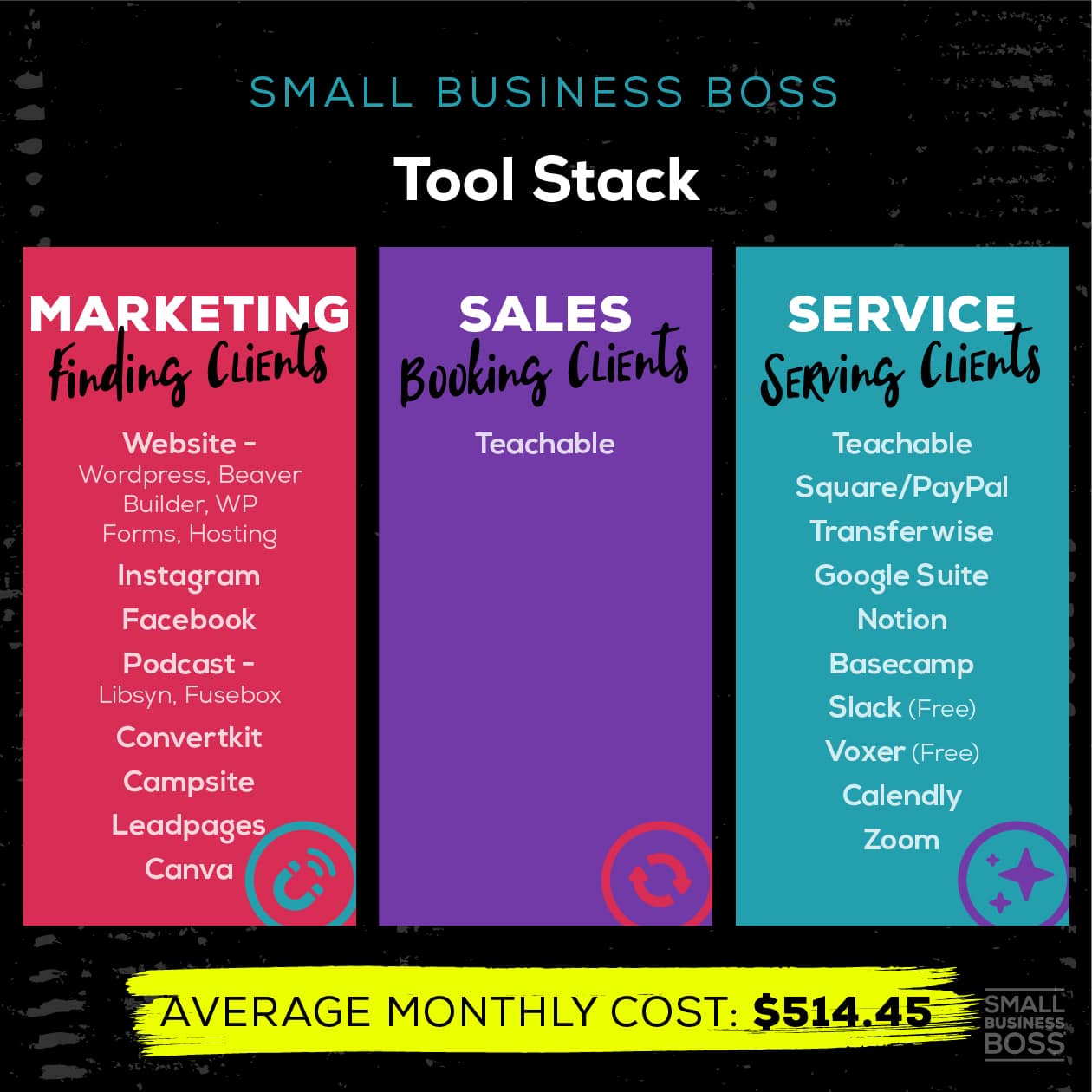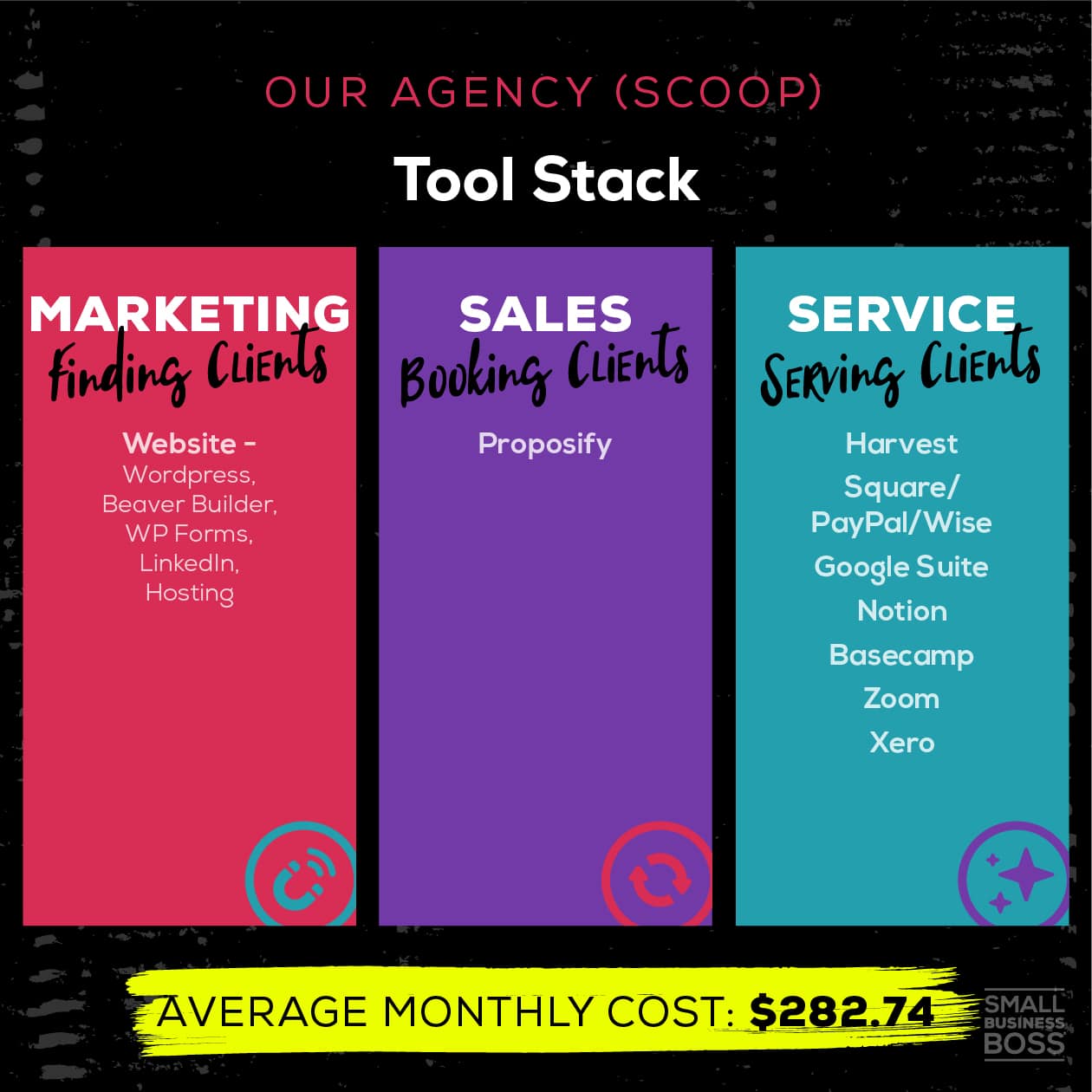What You Need to Know About
Done-For-You vs. Coaching-Based Business Models
By Maggie Patterson
All opinions in this post are my opinions and mine alone.
Table of Contents
The Dream of the Coaching & Group Program Models
Time Breakdown: How I Really Spend My Time
Takeaways: What We Can Learn From My Time Analysis
Marketing Time Breakdown: What It Takes to Market My Business
Takeaways: Marketing is Part of Your Job, Especially as a Coach
Tools Breakdown: What We Use and How Much It Costs
Takeaways: Tools Don’t Automatically Make You Money
Listen Now To This Essay On The BS-Free Service Business Show
When it comes to running a service business, it can be a challenge to know what exactly the best path ahead is for you. Especially when the predominant messages in the online world are loud, shiny, and push a very limited set of options as being the best ones.
That’s why in this episode, we’re looking at the key differences between running a done-for-you service business, and one that offers coaching, including the hard numbers from my own experiences working in both models.
The Dream of the Coaching & Group Program Models

Amid the dreams being sold of what it's like to move away from services or to get away from having to create deliverables for clients, there’s essentially zero discussion of what’s actually required to run each type of business.
It’s something I constantly think about as I run two very different service businesses.
First, there’s my content marketing agency, Scoop where we work with mainly B2B companies in the tech and professional services space. We offer content strategy and production services, and revenue comes from a combination of projects and retainers.
Then, there’s my business that’s attached to this podcast, Small Business Boss where we offer strategic consulting in the form of half-day intensives, and three masterminds which include a range of group coaching, community, and 1:1 support.
Both of these businesses have incredibly different requirements in terms of marketing, operating costs, and my time. It’s something I’ve known for years, especially as we’ve become more disciplined about tracking this information separately.
As I looked at that data more and more, what I found was fascinating. Especially when I looked at how those time/money costs are compared to my revenue from each business.
This brings me to what I want to get into today. I’m going to share these details with you as a way to illustrate how very different done-for-you services are vs. coaching (both 1:1 and group programs).
Here’s what you may want to consider before switching up your business to chase the hottest online business trend.
Time Breakdown: How I Really Spend My Time
How I spend my time is definitely one of the top five questions I get from people once they learn I run two businesses.
Before I get fully into how my time breaks down, I want to be very clear that none of this would be possible without my team’s support. This includes both Sara, who’s my integrator covering both businesses, as well as our contractors who work in varying capacities for both Scoop and Small Business Boss.
Something you should know about me: I’m fanatical about tracking my time. It provides so much insight into what I’m really doing and helps keep me in check.
It’s also why I can provide such detailed information as part of this exercise.
For the purposes of this episode, I analyzed my time tracking from January 1st to June 30, 2021, to see how my time broke down between the two businesses.
As context, my average hours per week during this time was around the 40 hours mark, but that varied anywhere from 27 hours a week, up to 42 hours a week.
During that period, my time was 42.9% focused on Scoop and 57.1% on Small Business Boss.
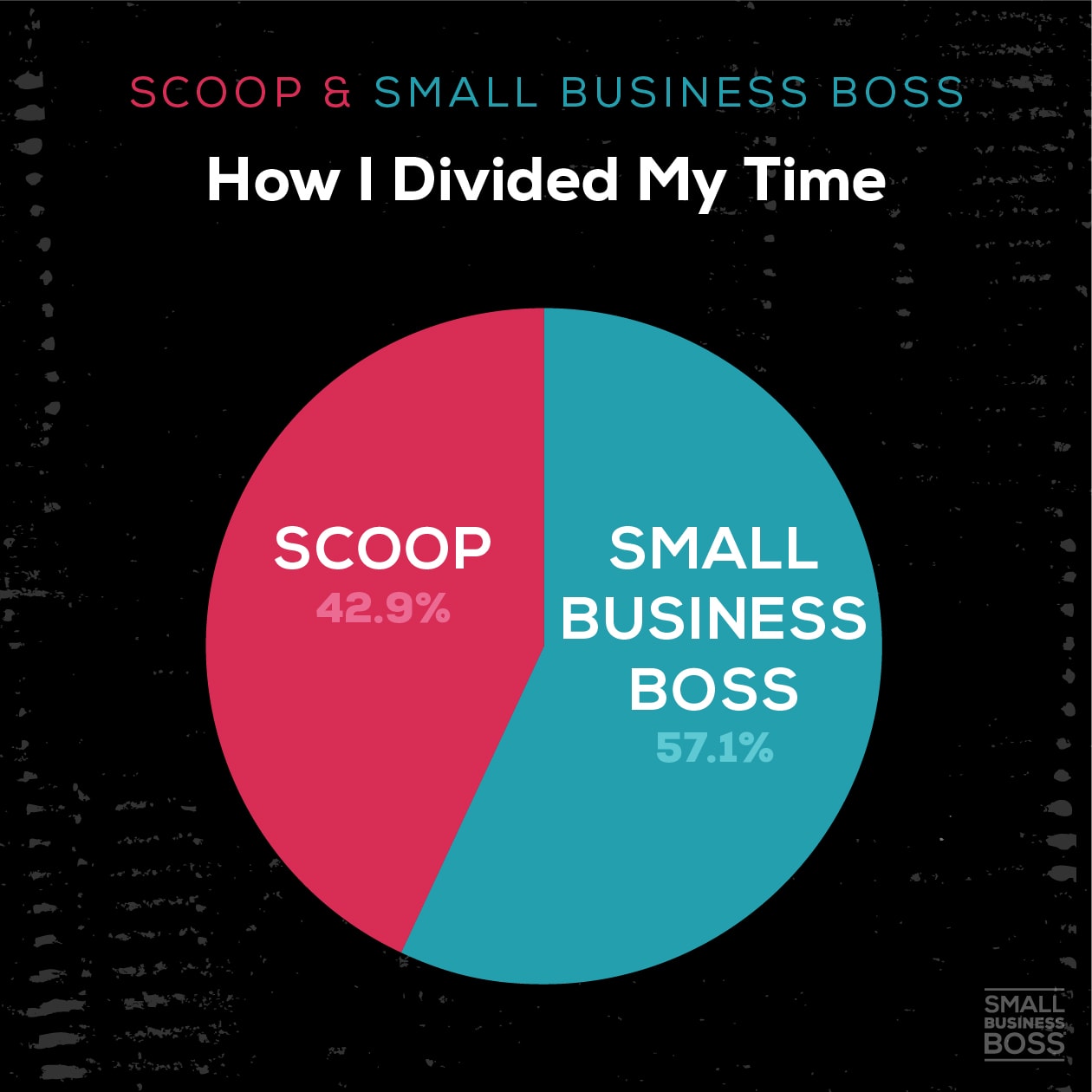
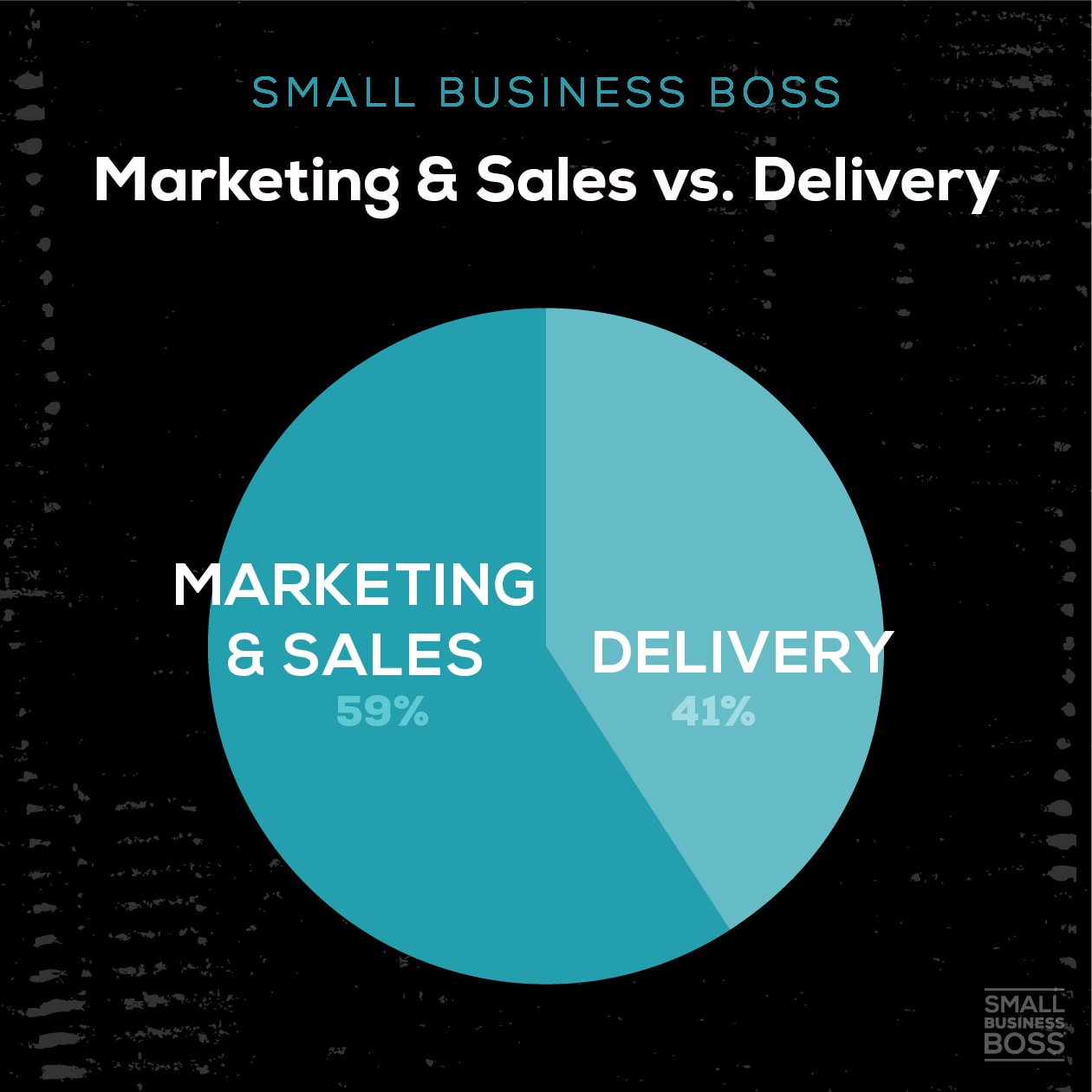
For Small Business Boss, my time is split between sales/marketing at 59% and delivery of our masterminds and intensives at 41%.
I’ll talk more about the marketing/sales efforts as that warrants some analysis in terms of the effort required to build and sustain Small Business Boss overall.
But let’s talk about what I’m calling delivery. This is time I spend delivering to Small Business Boss clients. Most of my time is spent with the members of our three masterminds, with only 10.3% of that time focusing on the BS-Free Business Intensive™ which is either a half-day or a one-hour session.
For the masterminds, there are three main buckets I spend my time on:
- Group Training - These are workshops, hot seats and retreats. This includes the content development for these sessions, as well as physically delivering them on Zoom.
- 1:1 Calls - For two of the masterminds, 1:1 calls are included, so I spend time every month in these sessions with members.
- Community Coaching & Support - This is a catchall that includes reviewing materials, answering questions and more via Slack and Voxer.
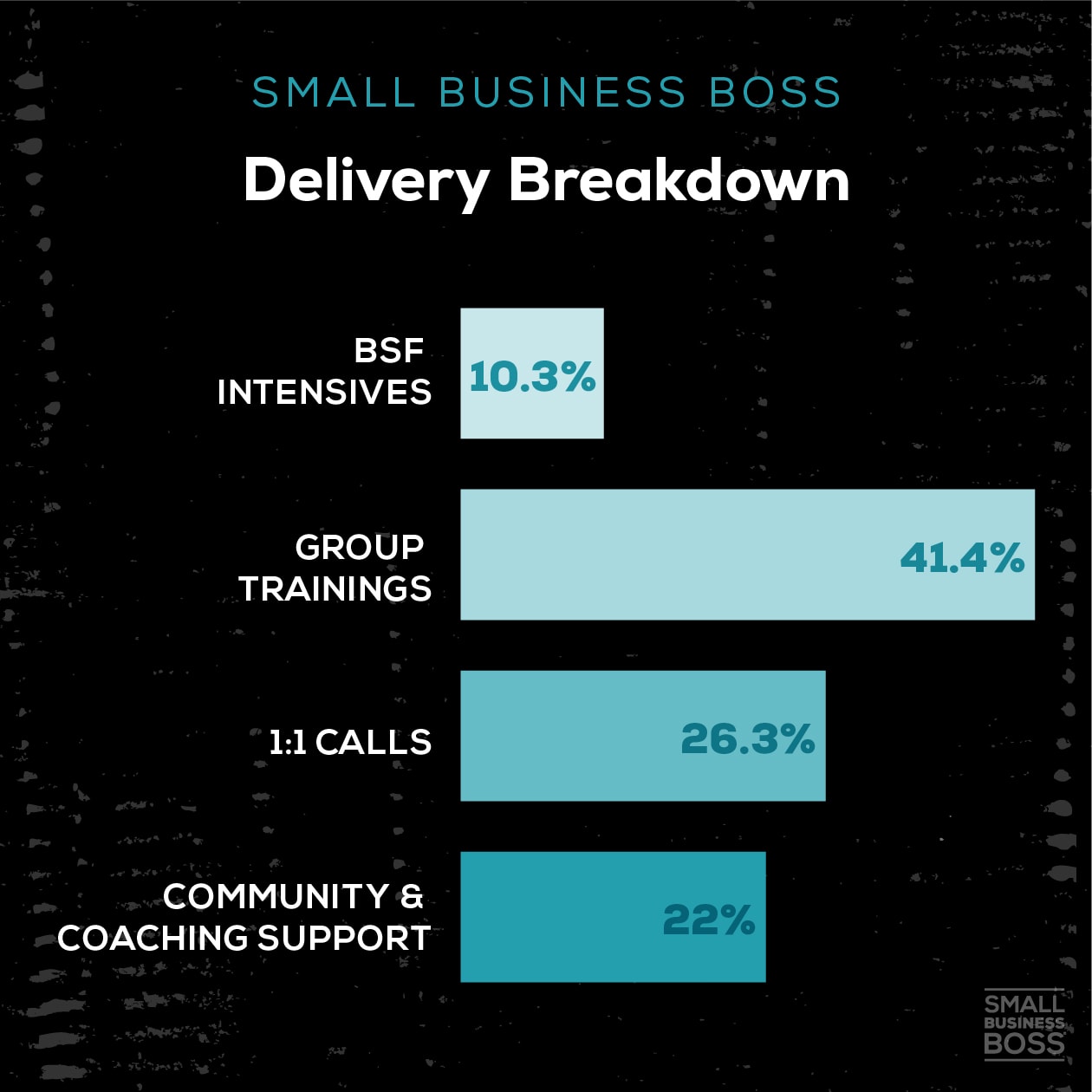
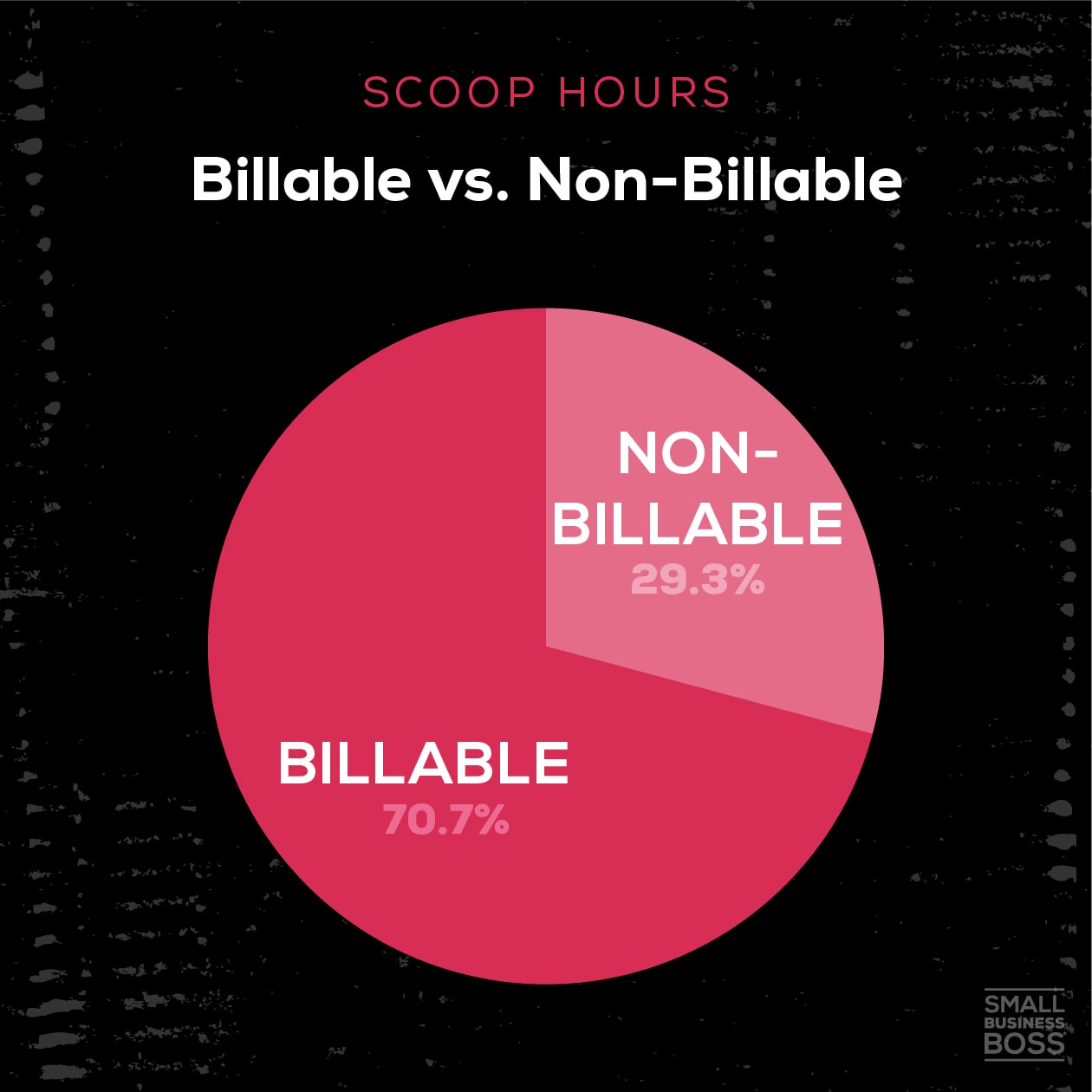
Now, let’s talk quickly about how I spend my time with Scoop. For 2021, my time has been 70.7% billable, and 29.3% non-billable.
This is a direct reflection of lower marketing and new business activity for 2021. I consider the agency to be in a bit of a holding pattern, as while we’re growing, it’s at a slower pace than previous years. Honestly, right now, we’re close to max capacity with agency clients, so marketing and new business aren’t a priority.
You can see how I’m spending the majority of my non-billable time on the business of running an agency versus growth-focused ones. My time is heavily focused on team and administrative tasks at this point, which I expect will change and evolve once we build some further capacity by hiring and are in a position to take on more clients.
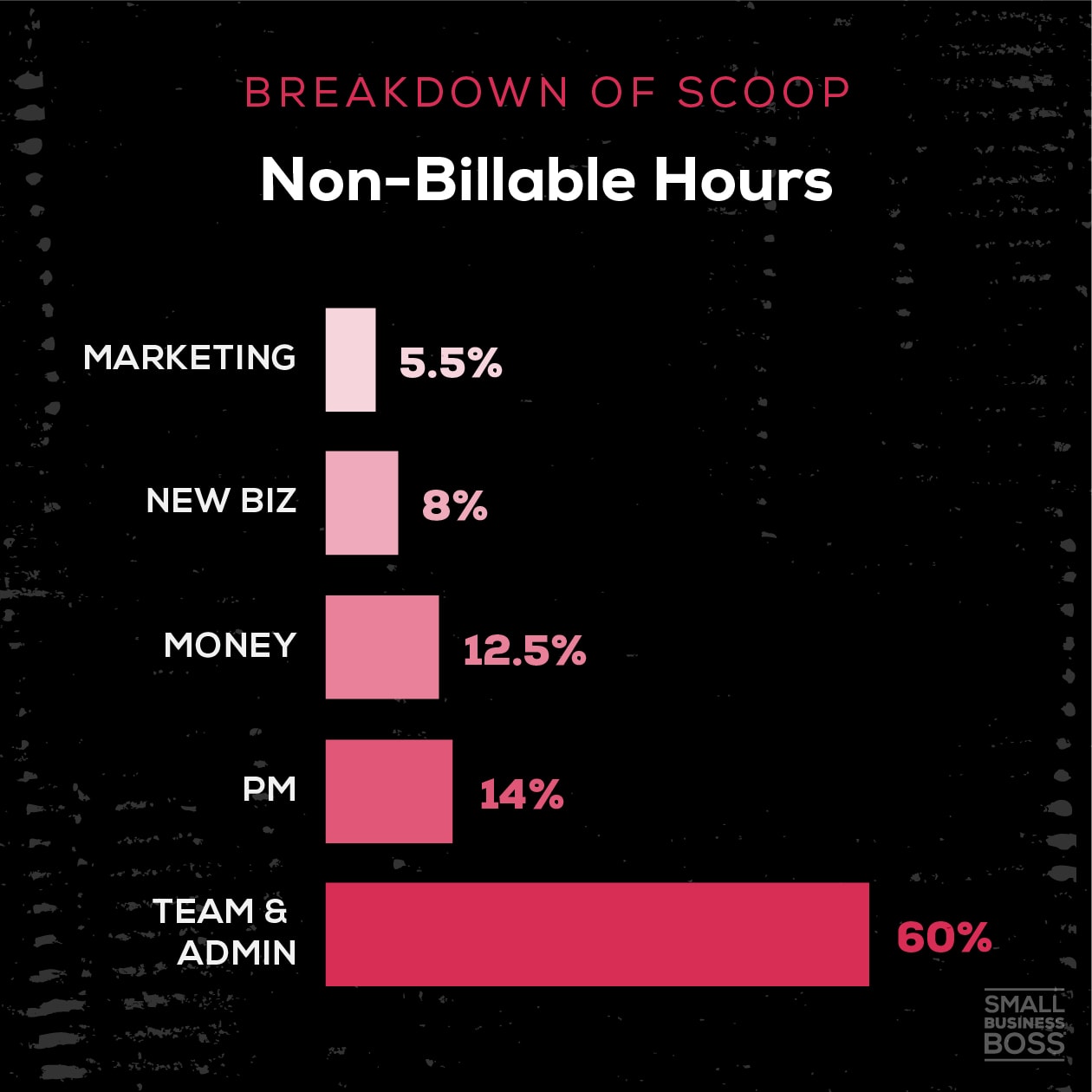
Takeaways: What We Can Learn From My Time Analysis
A big takeaway from this is that when you consider a coaching-driven or group program-focused business, you need to be ready to invest in both the marketing/sales of that offer, as well as the delivery. Both require me to show up in a way that connects with potential clients and collaborate with current ones on an ongoing basis.
Within the online space, there’s so much focus put on the ease of the coaching/programs business model, but there’s very little discussion of the energetic requirements of doing so. As much as I love this business, it’s definitely much more demanding of my creativity and energy than it is for the agency where we’re offering done-for-you services.
On the agency side, I have far fewer calls and time commitments, and generally, I have time to do deep work that’s directly and immediately tied to generating revenue. Whether you run an agency, or are flying solo, there’s a lot to be said for the simplicity and ease of this model, especially as it’s typically less marketing and sales intensive.
Marketing Time Breakdown: What It Takes to Market My Business
Now, let’s talk marketing as in the time breakdown I touched on how much time I spend marketing the Small Business Boss brand. (Again, these numbers are from January 1st to June 30th, 2021)
My marketing time is significant, as it’s about 34% of my total work time in any given month.
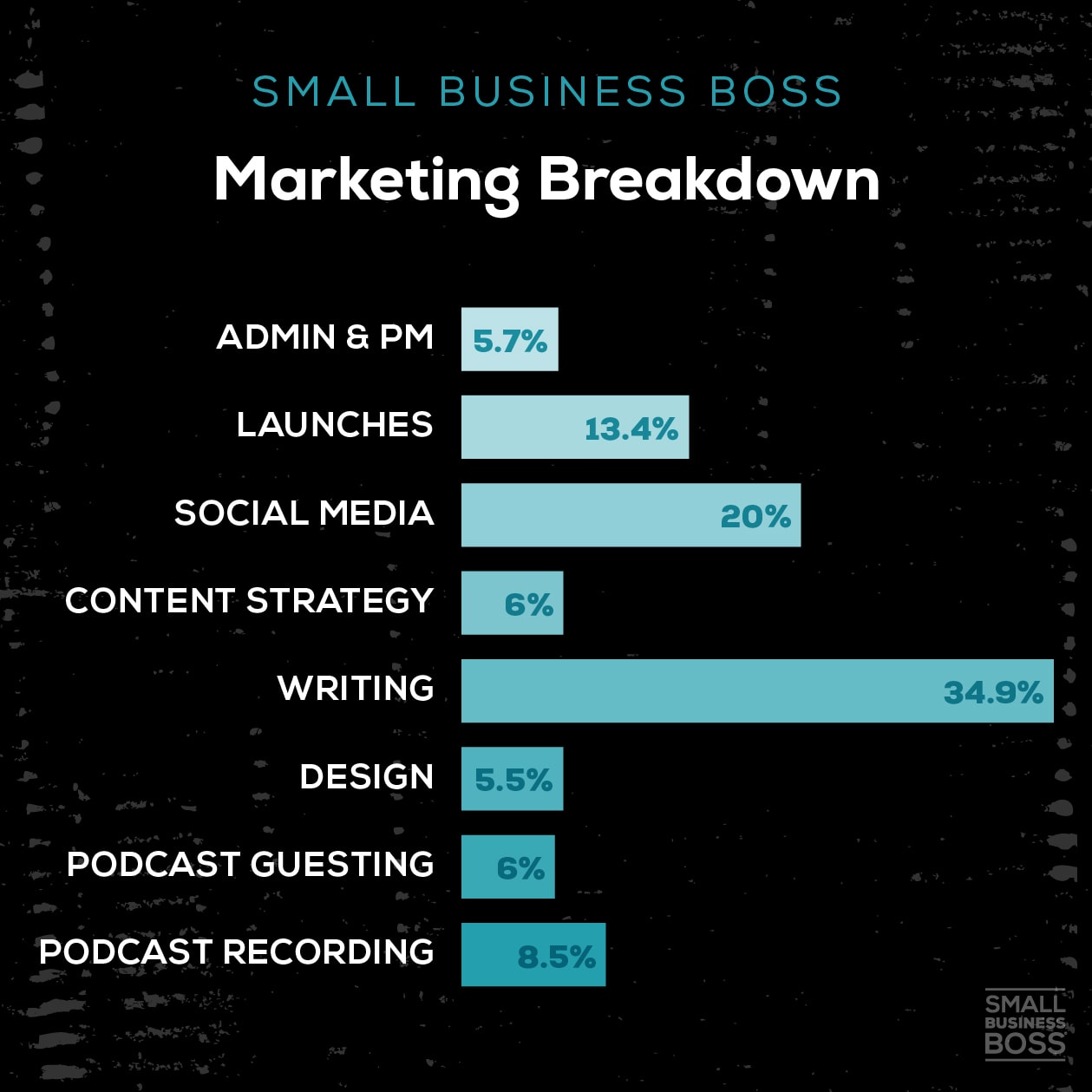
My marketing related time for Small Business Boss breaks down as follows:
- Admin/PM - General project management and team management related to Small Business Boss.
- Launches - This is everything from sales pages to sales calls. In the six months I analyzed, we had two mastermind launches.
- Social Media - This is basically the time I spend on Instagram posting, and mainly in the DMs and/or commenting.
- Content Strategy - With one main podcast and two limited series podcasts, plus social and email marketing, planning time is set aside every month on the strategy side.
- Writing - This is the biggest chunk of my time, which I love. But remember, I’m a writer. That’s why I got into communications in the first place. This is researching and writing podcast episodes, essays, social media and emails…..and everything else you can imagine.
- Design - I have a designer who’s on contract who handles the bulk of things. This is mainly me coming up with ideas and sharing them with her, and the random IG graphics I whip up in Canva.
- Podcast Guesting - This is everything from doing the interviews to coordinating and preparing for them.
- Podcast Recording - This is time spent on recording all the podcast episodes I currently have in production, which for this time period was the BS-Free Service Business Show and Duped.
I do want to call out how much time I spend on writing, as that’s literally 12% of my overall work time and nearly 35% of my marketing time. It comes down to the fact that creating quality content of any kind (video, written, podcasts, social, email) takes time, and most of all, it takes energy to conceive and create it.
Do I think I will continue to create at this pace forever? Definitely not. Right now I have a lot to say, but I’m also mindful of the fact that my energy may shift and we’ll slow things down content-wise in a big way.
Now, let’s talk about my marketing on the agency side, which was 1.2% of my total time. There’s really not that much to talk about as it’s been a real nothingburger by design this year. We’ve done a few blog posts which were written by my team, and until we’re in a position where we have more capacity, I expect this will continue to be the case.
That said, it’s a testament to the fact that with a done-for-you service business, you don’t need nearly as much marketing as with other service business models. And if you don’t work in the Business-to-Entrepreneur (B2E) space, you likely need even less.
Takeaways: Marketing is Part of Your Job, Especially as a Coach
Real Talk: Marketing is the part where online business, as an industry, gets it wrong.
We talk about tactics and strategies, but we don’t discuss how when you want to build a business as a coach or running group programs in the B2E, that MARKETING is a massive part of your role.
Especially as the bulk of marketing for B2E businesses relies on one-to-many marketing where you’re building a platform.
If you don’t love marketing or have the drive to learn the strategies and tactics, you may find it challenging. Yes, you can learn it, or hire it out, but there’s way more to it than anyone really talks about.
When it comes to hiring help with marketing, very few people have the resources to do so right out of the gate. So if you really don’t like marketing/sales, moving to a coaching or group program model (no matter what the celebrity entrepreneurs promise you) isn’t going to magically fix that. In fact, it may demand much, much more from you than you expect.
The done-for-you service business owners (mostly creatives) that I work with do a minimal amount of marketing and are reaching their business goals. These business owners rely more on one-to-one-based marketing methods like referrals, introductions, collaborations, and networking.
If you don’t love marketing, running a done-for-you service business that’s less demanding for you to find clients may be a better fit than others in the long term.
Revenue Breakdown: What My Numbers Reveal
Now that we’ve looked at the time, marketing, and tools required to run both types of business, I’m sure you’re interested in knowing how that plays when it comes to revenue.
To recap the numbers, check out this breakdown.
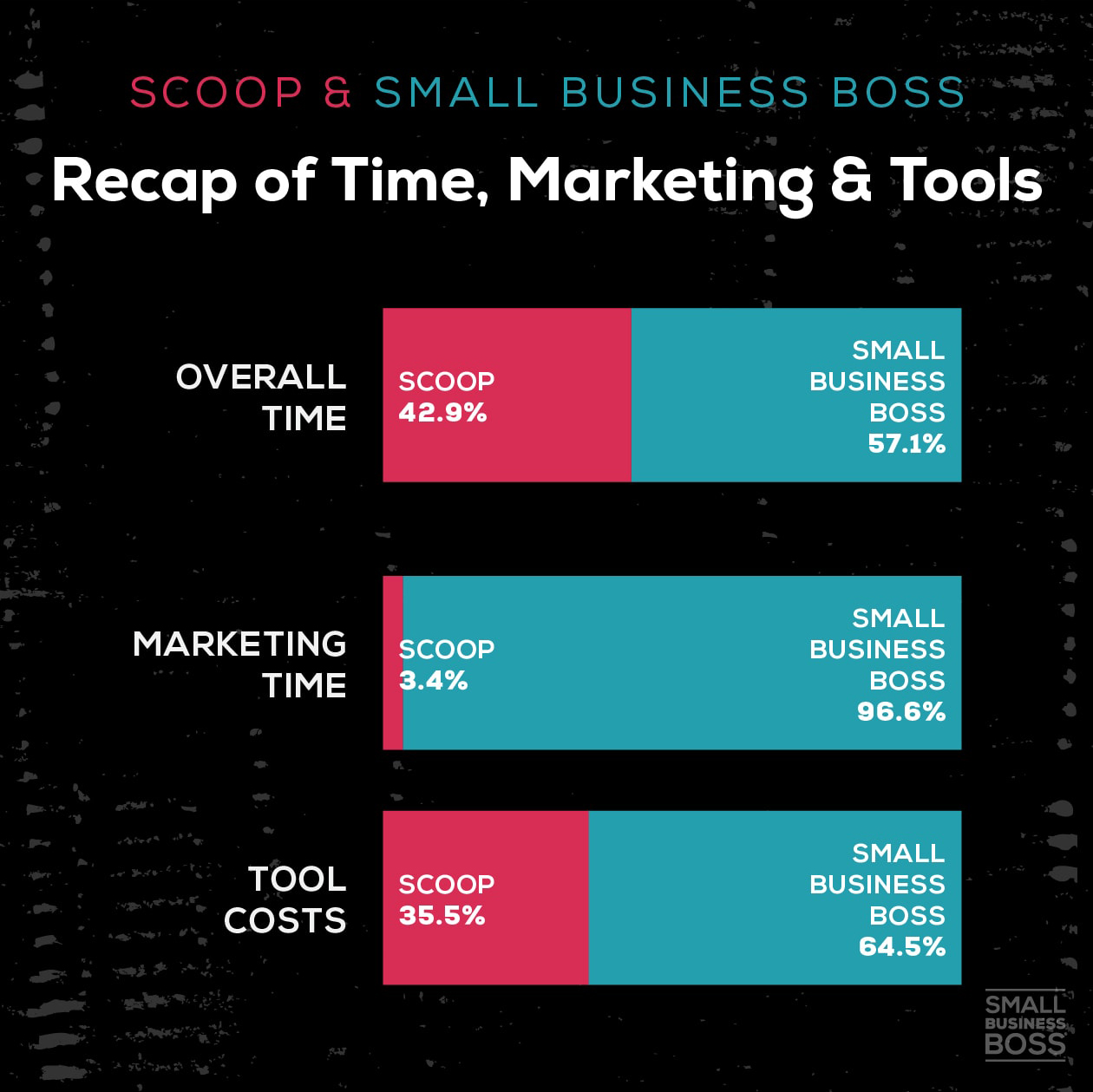
It’s clear that Small Business Boss requires a bigger time and financial investment to run than Scoop. But does the revenue line up with that?
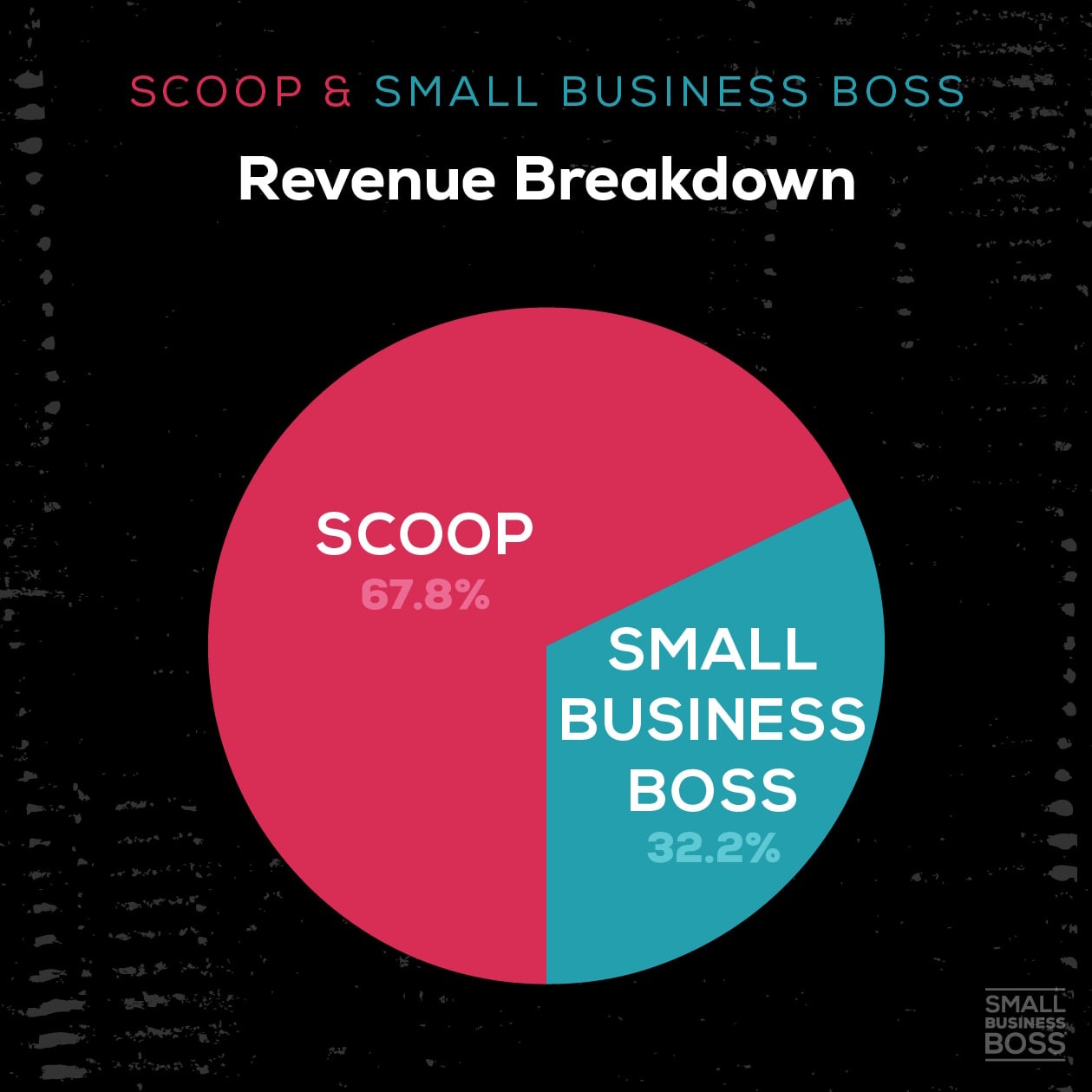
It's clear based on these numbers it simply does NOT.
As always these are revenue percentages only. I don’t engage in income claim marketing as a practice, you can read why here.
In a world that pushes the coaching/group program model of business, these numbers gave me pause. Sure, if I worked on Small Business Boss full-time, we’d generate more revenue, but the amount of effort and energy would rise accordingly.
Yes, I know all the things I could do that would help Small Business Boss generate more revenue, but many of those business practices such as high ticket pricing and no 1:1 support aren’t how I want to run my business.
Plus, the reality is that before people can do those things, they tend to offer 1:1 coaching and group programs with 1:1 calls, so this is a fair and accurate comparison.
In my case, the numbers are clear. Done-for-you services are simpler to offer, require less energy and time, and ultimately generate more revenue.
